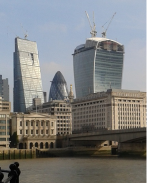[caption id="" align="alignright" width="300"] Tyrannosaurus rex, Palais de la Découverte, Paris (Photo credit: Wikipedia)[/caption]
Evolution is the natural process by which all forms of life adapt to changes in their environment. It is a very slow process, in which many small changes gradually accumulate. It is unplanned and undirected: who knows how the environment may change in the future, and so what adaptations would put us ahead of the game? Successful changes are not necessarily the best possible choices, merely the best of those that were tested. Different individuals start from different places, and so the adaptations which seem to work will vary. Consequently, over time, divergence will occur until different species result, even though each species can be traced back to a common ancestor. But evolution is brutal too: not all species will make it. Some find they have gone down an evolutionary dead end, and some that change is simply too fast for them to adapt to.
Sometimes organisational change can be like this. I once worked for a public-sector organisation which was privatised, so that it had to change from being ‘mission-led’ to being profit-led. Management set out a vision for what it wanted the organisation to become – essentially a similar, unitary, organisation but in the private sector – but was unable to make the radical changes necessary to deliver it fast enough. Evolution carried on regardless as the primary need to survive forced short-term decisions which deviated from the vision. Without a unifying mission as a common guide, different parts of the organisation evolved in different ways to adapt to their own local environments. Fragmentation followed, with a variety of different destinies for the parts, and a few divisions falling by the wayside. Despite starting down their preferred route of unitary privatisation, the eventual destination was exactly what the original managers had been determined to avoid.
What is the lesson? Ideally of course it should be possible to set out a strategic objective, and then to deliver the changes needed to get there. But if the change required is too great, or the barriers mean change is brought about too slowly, the short-term decisions of evolution may shape the future without regard to management intentions. That does not necessarily make the outcome worse in the greater scheme of things: after all, evolution is about survival of the fittest. But natural selection is an overwhelming force, and if short-term decisions are threatening to de-rail management’s strategic plan, it may be wise to take another look at the plan, and to try to work with evolution rather than against it.
Tyrannosaurus rex, Palais de la Découverte, Paris (Photo credit: Wikipedia)[/caption]
Evolution is the natural process by which all forms of life adapt to changes in their environment. It is a very slow process, in which many small changes gradually accumulate. It is unplanned and undirected: who knows how the environment may change in the future, and so what adaptations would put us ahead of the game? Successful changes are not necessarily the best possible choices, merely the best of those that were tested. Different individuals start from different places, and so the adaptations which seem to work will vary. Consequently, over time, divergence will occur until different species result, even though each species can be traced back to a common ancestor. But evolution is brutal too: not all species will make it. Some find they have gone down an evolutionary dead end, and some that change is simply too fast for them to adapt to.
Sometimes organisational change can be like this. I once worked for a public-sector organisation which was privatised, so that it had to change from being ‘mission-led’ to being profit-led. Management set out a vision for what it wanted the organisation to become – essentially a similar, unitary, organisation but in the private sector – but was unable to make the radical changes necessary to deliver it fast enough. Evolution carried on regardless as the primary need to survive forced short-term decisions which deviated from the vision. Without a unifying mission as a common guide, different parts of the organisation evolved in different ways to adapt to their own local environments. Fragmentation followed, with a variety of different destinies for the parts, and a few divisions falling by the wayside. Despite starting down their preferred route of unitary privatisation, the eventual destination was exactly what the original managers had been determined to avoid.
What is the lesson? Ideally of course it should be possible to set out a strategic objective, and then to deliver the changes needed to get there. But if the change required is too great, or the barriers mean change is brought about too slowly, the short-term decisions of evolution may shape the future without regard to management intentions. That does not necessarily make the outcome worse in the greater scheme of things: after all, evolution is about survival of the fittest. But natural selection is an overwhelming force, and if short-term decisions are threatening to de-rail management’s strategic plan, it may be wise to take another look at the plan, and to try to work with evolution rather than against it.
 Tyrannosaurus rex, Palais de la Découverte, Paris (Photo credit: Wikipedia)[/caption]
Evolution is the natural process by which all forms of life adapt to changes in their environment. It is a very slow process, in which many small changes gradually accumulate. It is unplanned and undirected: who knows how the environment may change in the future, and so what adaptations would put us ahead of the game? Successful changes are not necessarily the best possible choices, merely the best of those that were tested. Different individuals start from different places, and so the adaptations which seem to work will vary. Consequently, over time, divergence will occur until different species result, even though each species can be traced back to a common ancestor. But evolution is brutal too: not all species will make it. Some find they have gone down an evolutionary dead end, and some that change is simply too fast for them to adapt to.
Sometimes organisational change can be like this. I once worked for a public-sector organisation which was privatised, so that it had to change from being ‘mission-led’ to being profit-led. Management set out a vision for what it wanted the organisation to become – essentially a similar, unitary, organisation but in the private sector – but was unable to make the radical changes necessary to deliver it fast enough. Evolution carried on regardless as the primary need to survive forced short-term decisions which deviated from the vision. Without a unifying mission as a common guide, different parts of the organisation evolved in different ways to adapt to their own local environments. Fragmentation followed, with a variety of different destinies for the parts, and a few divisions falling by the wayside. Despite starting down their preferred route of unitary privatisation, the eventual destination was exactly what the original managers had been determined to avoid.
What is the lesson? Ideally of course it should be possible to set out a strategic objective, and then to deliver the changes needed to get there. But if the change required is too great, or the barriers mean change is brought about too slowly, the short-term decisions of evolution may shape the future without regard to management intentions. That does not necessarily make the outcome worse in the greater scheme of things: after all, evolution is about survival of the fittest. But natural selection is an overwhelming force, and if short-term decisions are threatening to de-rail management’s strategic plan, it may be wise to take another look at the plan, and to try to work with evolution rather than against it.
Tyrannosaurus rex, Palais de la Découverte, Paris (Photo credit: Wikipedia)[/caption]
Evolution is the natural process by which all forms of life adapt to changes in their environment. It is a very slow process, in which many small changes gradually accumulate. It is unplanned and undirected: who knows how the environment may change in the future, and so what adaptations would put us ahead of the game? Successful changes are not necessarily the best possible choices, merely the best of those that were tested. Different individuals start from different places, and so the adaptations which seem to work will vary. Consequently, over time, divergence will occur until different species result, even though each species can be traced back to a common ancestor. But evolution is brutal too: not all species will make it. Some find they have gone down an evolutionary dead end, and some that change is simply too fast for them to adapt to.
Sometimes organisational change can be like this. I once worked for a public-sector organisation which was privatised, so that it had to change from being ‘mission-led’ to being profit-led. Management set out a vision for what it wanted the organisation to become – essentially a similar, unitary, organisation but in the private sector – but was unable to make the radical changes necessary to deliver it fast enough. Evolution carried on regardless as the primary need to survive forced short-term decisions which deviated from the vision. Without a unifying mission as a common guide, different parts of the organisation evolved in different ways to adapt to their own local environments. Fragmentation followed, with a variety of different destinies for the parts, and a few divisions falling by the wayside. Despite starting down their preferred route of unitary privatisation, the eventual destination was exactly what the original managers had been determined to avoid.
What is the lesson? Ideally of course it should be possible to set out a strategic objective, and then to deliver the changes needed to get there. But if the change required is too great, or the barriers mean change is brought about too slowly, the short-term decisions of evolution may shape the future without regard to management intentions. That does not necessarily make the outcome worse in the greater scheme of things: after all, evolution is about survival of the fittest. But natural selection is an overwhelming force, and if short-term decisions are threatening to de-rail management’s strategic plan, it may be wise to take another look at the plan, and to try to work with evolution rather than against it.  How often have you found yourself having a conversation, and it gradually dawning on you that the person you are talking to thinks the conversation is about something quite different to what you thought? It happens to us all from time to time, and normally it causes at worst mild embarrassment as one of you says, ‘hang on a minute, I thought we were talking about x’ and the other looks bemused. Sometimes though, miscommunication can cause real problems.
How often have you found yourself having a conversation, and it gradually dawning on you that the person you are talking to thinks the conversation is about something quite different to what you thought? It happens to us all from time to time, and normally it causes at worst mild embarrassment as one of you says, ‘hang on a minute, I thought we were talking about x’ and the other looks bemused. Sometimes though, miscommunication can cause real problems.
E-mail Fireworks
Perhaps the most common place for miscommunication to cause problems in the working world is in e-mails. Maybe the relationship is a bit sticky already, or perhaps the subject is emotive. You write an e-mail, for example telling someone what you are going to do. Writing the message down gives you a chance to choose the words carefully so that they can’t be misinterpreted, right? Wrong! Within a few microseconds of pressing the ”send” button, you notice that your computer has started to smoke from the heat in the reply that has just clanged into your inbox. You read it – how could they have misunderstood your intentions so wildly? They must be spoiling for a fight! Your emotion finds its way into your reply, and the exchange just escalates. E-mail fireworks are never productive. Why are e-mails so fraught? Mainly, they are too easy. We dash them off with little thought. For straightforward factual messages that is not a problem. The trouble comes when the exchange has some (often unexpected) emotional content. Although they seem like a way of keeping the emotion out and so appear to be an easy option, humans are emotional creatures: we don’t often do purely rational. Be especially careful when you are worried about the reaction, and it feels safer to keep your distance. By omitting the emotional context of the message, which we detect mostly from body language and tone of voice, we take away the very cues which would help the recipient to know whether we meant to be provocative or were just not choosing our words very well. Poorly-chosen words in the context of a friendly tone and an open expression will usually only prompt clarification, but without these, people usually assume the worst. Here are five tips for minimising the risk of e-mail fireworks, and getting things back on track if necessary:- If you think the message might have some emotional content, don’t rely on e-mail if you can possibly avoid it. Start the exchange face-to-face, or at least with a phone call, so that there is an emotional context. Only once the tone has been set should you follow it up with an email.
- If you didn’t think the message was emotional, but the response appears to be – or even just indicates misunderstanding - never send an email reply. Pick up the phone straight away to clarify, or go and see them if you can.
- If you have to send an email which you know may be emotive, save a draft overnight before sending it, and re-read it in the morning. You have a better chance then of seeing how someone else might mis-interpret your words, and stopping it before it is too late. I rarely find I change nothing the next day!
- For really sensitive messages which you have to put in writing, ask someone else to check your words before you send them.
- If an exchange has gone emotional, apologise face to face – even if you don’t think you have anything to apologise for.
[caption id="" align="alignright" width="300"] Wing mirror VW Fox (Photo credit: Wikipedia)[/caption]
Last week I had to drive my daughter to France to start a year of study at a French University. As you can imagine, the (small) car was packed to the roof with all the things she needed, or at least believed she needed, and which could not possibly get there any other way. Result – the rear view mirror only gave me a view of some pillows, which was not a lot of help. However, I very quickly adjusted to relying entirely on the wing mirrors, and felt reasonably safe even though I was driving on the ‘wrong’ side of the road.
The strange thing was that on the return journey, having unloaded in Nantes, I continued in the same way. It was only chance that I glanced in the direction of the main mirror, and realised that it was (of course) no longer obstructed. Information inertia!
Wing mirror VW Fox (Photo credit: Wikipedia)[/caption]
Last week I had to drive my daughter to France to start a year of study at a French University. As you can imagine, the (small) car was packed to the roof with all the things she needed, or at least believed she needed, and which could not possibly get there any other way. Result – the rear view mirror only gave me a view of some pillows, which was not a lot of help. However, I very quickly adjusted to relying entirely on the wing mirrors, and felt reasonably safe even though I was driving on the ‘wrong’ side of the road.
The strange thing was that on the return journey, having unloaded in Nantes, I continued in the same way. It was only chance that I glanced in the direction of the main mirror, and realised that it was (of course) no longer obstructed. Information inertia!
 Wing mirror VW Fox (Photo credit: Wikipedia)[/caption]
Last week I had to drive my daughter to France to start a year of study at a French University. As you can imagine, the (small) car was packed to the roof with all the things she needed, or at least believed she needed, and which could not possibly get there any other way. Result – the rear view mirror only gave me a view of some pillows, which was not a lot of help. However, I very quickly adjusted to relying entirely on the wing mirrors, and felt reasonably safe even though I was driving on the ‘wrong’ side of the road.
The strange thing was that on the return journey, having unloaded in Nantes, I continued in the same way. It was only chance that I glanced in the direction of the main mirror, and realised that it was (of course) no longer obstructed. Information inertia!
Wing mirror VW Fox (Photo credit: Wikipedia)[/caption]
Last week I had to drive my daughter to France to start a year of study at a French University. As you can imagine, the (small) car was packed to the roof with all the things she needed, or at least believed she needed, and which could not possibly get there any other way. Result – the rear view mirror only gave me a view of some pillows, which was not a lot of help. However, I very quickly adjusted to relying entirely on the wing mirrors, and felt reasonably safe even though I was driving on the ‘wrong’ side of the road.
The strange thing was that on the return journey, having unloaded in Nantes, I continued in the same way. It was only chance that I glanced in the direction of the main mirror, and realised that it was (of course) no longer obstructed. Information inertia!



